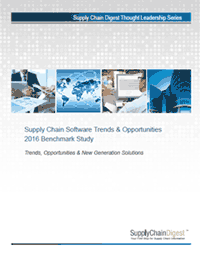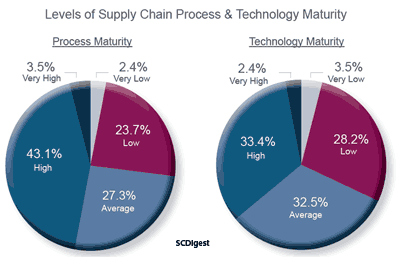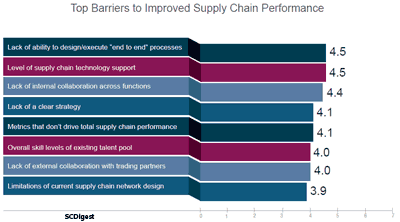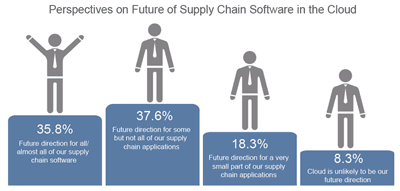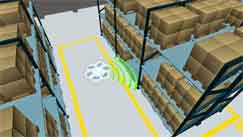 |
September 22, 2016 - Supply Chain Flagship Newsletter |
 |
| FEATURED SPONSOR: AMBER ROAD |
|||
 |
|||
| Download New eBook: Learn how Software can Help Consumer Goods Companies Move Into the Private Brand Market and Further Maximize Profitability |
|||
 |
|
||||||||||||||||||||||||||||||||||||||||||||||||||||||||||||||||||||||||||||||||||||||||||||||||||||||||||||||||||
|
|||||||||||||||||||||||||||||||||||||||||||||||||||||||||||||||||||||||||||||||||||||||||||||||||||||||||||||||||||
As is always the case, respondents ranked their level of supply chain process maturity ahead of how they viewed their supply chain technology capabilities, though not dramatically so. For example, 43.1% rated their process capabilities as high, versus 33.4% who felt this way about their supply chain technology. Similarly, the average score for process maturity was 4.1, just above the mid-point of 4.0, versus 3.7 - below the mid-point - for technology. Another view is that 26.1% of respondents rated their process capabilities as low or extremely low, versus 31.7% that placed their technology capabilities in the lower scores. We also asked respondents to rate a list of barriers to supply chain performance, on a similar 1 to 7 scale, with 1 being the least barrier, 7 the most. As can be seen below, the lack of ability to design/execute end-to-end processes came out on top, with an average score of 4.5, just ahead of overall level of supply chain technology support. A lack of internal collaboration across functions, a barrier that is in a sense similar to challenges with designing end-to-end processes, came in as the third ranked obstacle, with a score of 4.4. |
|||||||||||||||||||||||||||||||||||||||||||||||||||||||||||||||||||||||||||||||||||||||||||||||||||||||||||||||||||
Only "limitations in current supply chain design" fell below the mid-point in our list, and that just barely, with a score of 3.9. It is interesting to note that respondents saw lack of internal collaboration as a greater barrier to improved performance than they did a lack of external collaboration with trading partners. We were also surprised that "overall skill levels" didn't rank more highly, given all the press of late around a "talent crisis" in supply chain. There were a number interesting comments on this question that you will find in the full report. Ok, let's turn now to a couple of data points related to the Cloud sub-theme. We asked for each respondents' general view on deploying supply chain applications in the Cloud. As seen below, more than one-third of respondents said that Cloud will be "the future direction for all/almost all of our supply chain software," a percentage much higher than we would have seen just two years ago. What's more, another 37.6% indicated Cloud would be the "future direction for some but not all of our supply chain applications." Just over one quarter of respondents said that Cloud-based software would be adopted for only a small portion of total supply chain applications or not at all - and I bet they will turn out to be wrong. |
|||||||||||||||||||||||||||||||||||||||||||||||||||||||||||||||||||||||||||||||||||||||||||||||||||||||||||||||||||
Those providing Cloud-based supply chain software solutions promote many benefits from this approach. We wanted to see what respondents thought about these potential advantages, rating a series of benefits on our 1 to 7 scale, with 1 the least benefit and 7 the most. As can be seen in the chart below, faster deployments topped the list, with a very strong average score of 5.4. That was just ahead the directly related benefit of "faster time to value," with a score of 5.3. |
|||||||||||||||||||||||||||||||||||||||||||||||||||||||||||||||||||||||||||||||||||||||||||||||||||||||||||||||||||
But several other benefits in the list also had strong scores of 5.0 or higher, including ease of upgrades, total cost of ownership, lower IT support costs, and lower upfront costs. Only offering a "pay as you go" pricing model fell below the 5.0 mark, and even that was still well above the mid-point, with a score of 4.6. I've just scratched the surface of the interesting data in the excellent report. Take a look. Is Cloud-based supply chain software simply where it is all headed? Again, I say Yes.
What's your reaction to these data points? Do you believe supply chain software in the Cloud will soon dominate? Why or why not? Let us know your thoughts at the Feedback section below. |
|||||||||||||||||||||||||||||||||||||||||||||||||||||||||||||||||||||||||||||||||||||||||||||||||||||||||||||||||||
|
|||||||||||||||||||||||||||||||||||||||||||||||||||||||||||||||||||||||||||||||||||||||||||||||||||||||||||||||||||
|
|||||||||||||||||||||||||||||||||||||||||||||||||||||||||||||||||||||||||||||||||||||||||||||||||||||||||||||||||||
|
|
|
YOUR FEEDBACK
We received several short but interesting emails from David Schneider's gust Firsth Thoughts column on "In Supply Chain It Pays to Put it in Writing," which you will find below.
Feedback on Putting It in Writing
![]()
After you put it in writing, you should sign it and date it. Take one more look at the document prior to submitting or sending the document, and decide if you would accept the document as complete and on time.
The lesson I learned was that, if you put your name on a document, you are putting your name and reputation on the line. This applies to all documents, spreadsheets, or reports that are generated.
Joe Kirchner, CPIM
Senior Supply Chain Analyst
Ciber, Inc.
Note from David Schneider:
We are pulling from some deep places in the readership. Joe, 40 years ago we didn't call it Supply Chain, it was Physical Distribution, right?
This is a great practice you outline. Consider it a test that you have to put your name on at the top. Are you going to score high?
David K. Schneider
![]()
Thanks for a very detailed timeline of events to teach a valuable lesson.
I've learned this myself the hard way, as well as witnessed it carried out even more.
Basically, it's the old summation of "Why is there never any time to do something right the first time, yet there's always time to do it over?"
Jeff Branchick
![]()
I agree 100%. Got to put it in writing !!!!
Todd Basham
Senior Project Specialist – Rollouts and Special Projects
Estes Express Lines
![]()
SUPPLY CHAIN TRIVIA ANSWER
Q: Which city is not on the general rotation of host cities for the CSCMP annual conference: Chicago, Dallas, Philadelphia, San Antonio, Denver, San Diego?
A: Dallas.
| © SupplyChainDigest™ 2003-2016. All Rights Reserved. SupplyChainDigest PO Box 714 Springboro, Ohio 45066 |
POWERED BY: XDIMENSION
|






